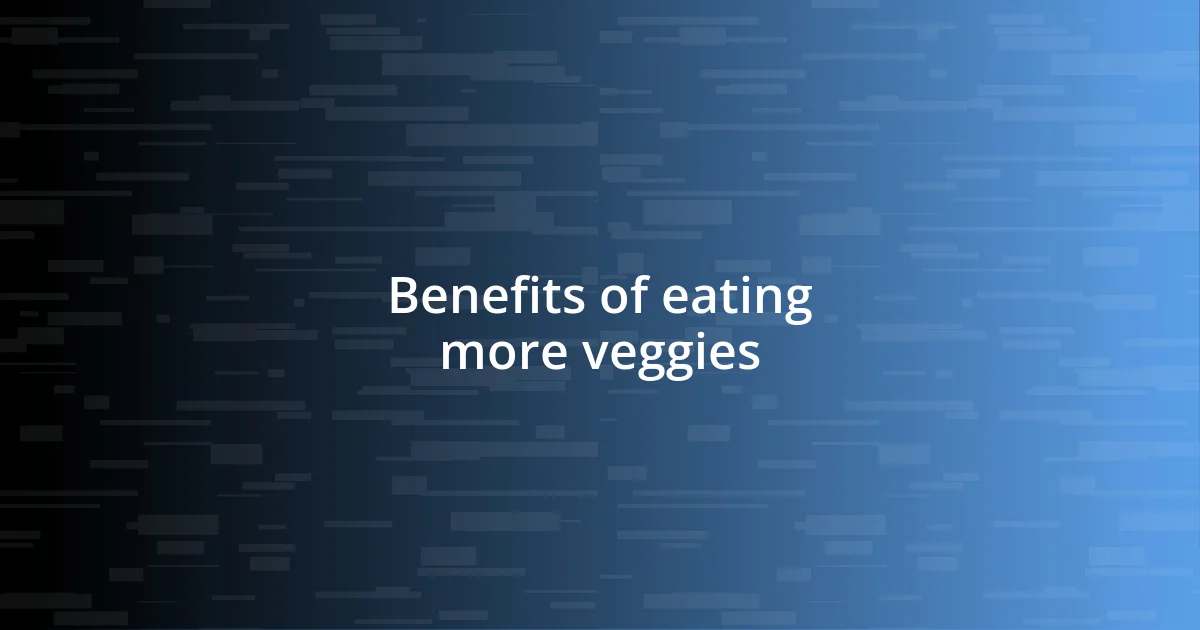Key takeaways:
- Increased vegetable intake boosts energy levels, mood, and digestive health.
- Setting manageable vegetable goals and prepping them in advance makes it easier to incorporate them into meals and snacks.
- Tracking vegetable consumption through journaling or apps enhances motivation and awareness of nutritional benefits.

Benefits of eating more veggies
When I first decided to up my veggie intake, I noticed a surprising change in my energy levels. Have you ever experienced that mid-afternoon slump? Adding more leafy greens and vibrant vegetables to my meals helped me stay focused and alert throughout the day. It’s amazing how much our bodies thrive on those nutrient-packed foods!
One of the standout benefits I’ve experienced is the boost to my overall mood. There’s something undeniably uplifting about vibrant colors on my plate. I remember one day, after preparing a colorful stir-fry with bell peppers and broccoli, I felt an instant sense of joy, as if the veggies were charging my spirit. The connection between what we eat and how we feel is truly profound, wouldn’t you agree?
Incorporating more veggies has also transformed my digestive health. Initially, I struggled with feeling bloated after meals; however, the fiber from vegetables has made such a difference. I now relish the crunch of raw carrots and the satisfaction of a hearty kale salad, knowing that they keep my system running smoothly. Have you ever considered how a simple habit can lead to such significant improvements in digestion?

Setting daily vegetable goals
Setting my daily vegetable goals was a game changer for me. At first, I felt overwhelmed by how many servings I should aim for, but then I realized that starting small made it manageable. I committed to adding just one extra serving of vegetables each day. It might seem minor, but I was amazed at the difference it made over time.
- I set a goal of one new veggie per week to keep things fresh.
- I marked a calendar to track my progress visually.
- I challenged myself to incorporate veggies into breakfast; think smoothies or omelets.
- I learned to pack my lunch with at least two servings of vegetables.
- I rewarded myself with a fun new recipe for every week I met my goals.
This approach not only made it fun but also provided me with a sense of accomplishment. I remember the satisfaction I felt after my first week of tracking—seeing that I had achieved my goal was so motivating!

Easy veggie prep techniques
I’ve found that prepping veggies can be a real time-saver. I like to dedicate a bit of my weekend to wash, chop, and store various vegetables in clear containers. This way, when I’m in a rush during the week, I can simply grab a handful of prepped veggies to toss into my stir-fries or salads. I can’t tell you how much easier it is to reach for a snack of carrot sticks or bell pepper strips when they’re already cut!
One technique I absolutely swear by is roasting veggies in bulk. I remember the first time I filled my oven with a mix of cauliflower, sweet potatoes, and Brussels sprouts tossed in olive oil and herbs. The aroma that filled my kitchen was heavenly! Not only did I have delicious sides ready for several meals, but the leftover veggies made for a fantastic addition to my breakfast omelet the next day. This kind of meal prep really makes it feel effortless to incorporate more veggies into my daily routine.
Steaming is another easy method to keep vegetables vibrant and full of nutrients. I use a simple steamer basket for my broccoli or green beans, and just a few minutes does the trick. I recall steaming a big batch of mixed vegetables for a family dinner, and everyone loved them! It felt rewarding to see my loved ones enjoying their veggies while I knew I had added a healthy touch to our meal. Plus, having those steamed veggies ready to go in the fridge means I can quickly add them to any dish throughout the week without a second thought.
| Prep Technique | Advantages |
|---|---|
| Chopping and Storing | Time-saving; encourages snacking on veggies. |
| Bulk Roasting | Flavorful and versatile for multiple meals. |
| Steaming | Retains nutrients; quick and easy veggie addition. |

Incorporating veggies in meals
I’ve discovered that incorporating veggies into meals doesn’t have to be complicated. For instance, I love throwing a handful of spinach into my morning smoothie; it boosts the nutrition without altering the taste much. I remember my first attempt—I was half-expecting a green smoothie to taste awful, but it was delicious! It made me wonder why I hadn’t done it sooner.
When it comes to dinner, I find that adding a medley of vegetables to my pasta makes a world of difference. Last week, I sliced up zucchini and cherry tomatoes and tossed them in with my spaghetti. The colors brightened the dish, and their natural sweetness complemented the sauce beautifully. Each bite took me back to sunny summer markets, where fresh produce made everything better. Who knew a simple veggie addition could evoke such memories?
I’ve also enjoyed experimenting with veggie-packed wraps for lunch. I wrap roasted peppers, spinach, and hummus in a whole grain tortilla for a quick meal on the go. The first time I tasted this combo, it felt like a burst of flavors that overshadowed any boring sandwich I had packed before. Have you tried using wraps as a canvas for your favorite veggies? It’s an easy way to make meals more exciting and fulfilling.

Snack options with vegetables
Snacking on veggies doesn’t have to be bland—there are so many vibrant options that can really satisfy hunger between meals. One of my go-to snacks is a crunchy veggie platter. I love pairing an array of colorful veggies like cucumber slices, cherry tomatoes, and radishes with a creamy hummus dip. I remember serving this to my friends during a game night, and their surprised faces as they reached for veggies instead of chips was priceless. It felt rewarding to introduce them to a healthier option that turned out to be crowd-pleasing!
Another fantastic snack option I often indulge in is roasted chickpeas seasoned with paprika and garlic powder. They’re crispy, flavorful, and a great source of protein. I first discovered this tasty treat during a cooking class, and I was amazed at how they kept my cravings at bay. Just tossing a batch in the oven while preparing dinner transformed my approach to snacking. Have you tried adding some spice to your veggies? It truly brings them to life!
One unconventional yet delightful option I’ve embraced is using veggie sticks dipped in a tangy salsa or guacamole. I vividly remember one lazy afternoon when I combined carrots and celery with homemade guacamole. The freshness of the guacamole made the dull crunch of raw veggies feel like a celebration! It’s a reminder that even the simplest preparations can turn into something extraordinary, inviting you to explore the delicious world of veggie snacking!

Creative ways to serve veggies
One of my favorite creative ways to serve veggies is by turning them into flavorful chips. I remember the first time I tried kale chips—I was skeptical at first, thinking chips could never be healthy. But after tossing kale leaves with olive oil and a sprinkle of sea salt before baking them into crisp perfection, I was hooked. They made a delightful snack, and I felt like I was treating myself while still doing something great for my body. Have you ever thought about using veggies in a new format to sneak in some nutrients?
Another fun idea is to incorporate veggies into breakfast. I often make savory oatmeal by mixing in roasted sweet potatoes and spinach. Last weekend, I added some sautéed onions and a poached egg on top. The creamy yolk combined with the subtle sweetness of the potatoes created a hearty dish that completely changed my breakfast game. Who knew my morning bowl could be so colorful and nourishing?
Lastly, I love using veggies as toppings for my baked dishes. For instance, I recently made a pizza with a homemade crust and topped it with roasted Brussels sprouts, red onion, and a drizzle of balsamic glaze. The combination of flavors was absolutely amazing! Every bite was a surprise, and it made me appreciate how versatile veggies can be. Have you ever thought about how changing up toppings can transform a meal?

Tracking your veggie intake
Tracking your veggie intake has become a game-changer for me. I started a simple food journal, jotting down every veggie I consumed throughout the day. There’s something satisfying about seeing those greens and colorful veggies add up; it motivates me to keep going. Have you ever tried writing down your meals? It’s eye-opening!
I often use a phone app to log my meals, and I find it incredibly helpful. Whenever I scan the barcode of a food item or enter ingredients, I’m reminded of the nutritional value behind each veggie. One day, I realized that my kale and spinach smoothies were not just delicious; they also packed a punch of vitamins. It’s like a little victory every time I see those numbers add up. Isn’t it fascinating how a bit of technology can enhance our healthy habits?
Another method I enjoy is meal prepping at the start of the week. By dedicating a couple of hours to chop and organize my veggies, I can easily toss them into meals throughout the week. Just last Sunday, I prepped a vibrant rainbow of bell peppers, carrots, and zucchini. It made my weekday cooking so much easier—and let’s be honest, who doesn’t want to cut down on kitchen time? Knowing I have nutritious options ready to go keeps my veggie game strong. How do you stay on top of your veggie intake?














